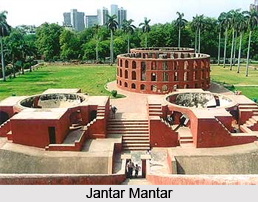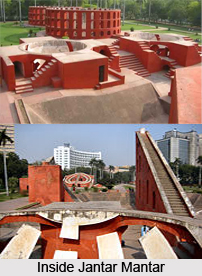 This unique structure was raised in 1724, and now lies in the heart of Delhi`s commercial center near Connaught place. This is the Jantar Mantar, one of several astronomical observatories raised by Maharaja Jai Singh II of Jaipur. The various intangible structures within the Jantar Mantar are, in fact, instruments that were used for keeping track of celestial bodies. Yet, Jantar Mantar is not only a timekeeper of celestial bodies, it also tells a lot about the technological achievements under the Rajput kings and their attempt to resolve the mysteries regarding astronomy. The Jantar Mantar of Delhi is only one of the five observatories built by Sawai Jai Singh II, the other four being located at Jaipur, Varanasi, Ujjain and Mathura.
This unique structure was raised in 1724, and now lies in the heart of Delhi`s commercial center near Connaught place. This is the Jantar Mantar, one of several astronomical observatories raised by Maharaja Jai Singh II of Jaipur. The various intangible structures within the Jantar Mantar are, in fact, instruments that were used for keeping track of celestial bodies. Yet, Jantar Mantar is not only a timekeeper of celestial bodies, it also tells a lot about the technological achievements under the Rajput kings and their attempt to resolve the mysteries regarding astronomy. The Jantar Mantar of Delhi is only one of the five observatories built by Sawai Jai Singh II, the other four being located at Jaipur, Varanasi, Ujjain and Mathura.
History
The Jantar Mantar was built far back in 1724-1730 AD during the period generally known as the dark age of Indian history, when the last great Mughal emperor Aurangzeb had died and the Mughal Empire was rapidly declining. During this uproaring period Muhammad Shah ascended the throne of the Mughal Empire. As many enemies surrounded him, he sought a coalition with the Hindu rulers. Of these, the most notable was Sawai Jai Singh II of Amber, who came into limelight since the days of Aurangzeb. When Jai Singh ascended the throne of Amber in 1699, he was barely eleven, but sharp and shrewd far beyond his years. The then Mughal emperor Aurangzeb was so impressed with the young ruler that he gave Jai Singh II the title of `Sawai`, meaning one and a quarter of an average man in worth.
Jai Singh`s idea was to create a rebirth of practical astronomy among the Indian masses and practicing astronomers. However, the superior ideals of the Jantar Mantar remained unfulfilled as the country at that time was in chaos and the full potential of this observatory was never realized. In the beginning, Jai Singh tried to use brass instruments in this observatory, but soon gave them up because of several natural errors. They were too small; for one thing, their axes were unstable so the center often got displaced. He then decided to follow the style adopted by the renowned Arab astronomer, Prince Ulugh Beg, builder of the famous 15th century observatory at Samarkand, Uzbekistan.
The massive masonry instruments at Samarkand suited Jai Singh`s architectural tastes and promised to be more accurate because of sheer size. In 1730, Jai Singh sent a mission to the king of Lisbon. On its return to Jaipur, the mission brought back a telescope and the court astronomer by the name of Xavier de Silva. This unique observatory was completed in 1724 and remained operational only for seven years.
Astronomical observations were regularly made over here and these observations were used for drawing up a new set of tables, later compiled as Zij Muhammad Shahi dedicated to the reigning monarch. Jai Singh named his observatory Jantar Mantar, which is actually pronounced, as `Yantra Mantra`, yantra for instrument and mantra for formula. A huge sundial known as "Samrat Yantra" or `Prince of Dials`, meant to measure accurate time of the day within half a second and the declination of the sun and other heavenly bodies dominates it. 
Jai Singh himself designed this yantra. Other yantras were also meant for the study of heavenly bodies, plotting their course and predicting eclipses. The two pillars on the southwest of Mishra Yantra are meant to determine the shortest and longest days of the year. Interestingly, in December one pillar completely covers the other with its shadow while in June it does not cast any such shadow at all. After the completion of the first Jantar Mantar and with a view to verifying astronomical observations made at Delhi, Jai Singh built similar, even if smaller observatories, at other important Indian cities-Jaipur, Varanasi, Ujjain, and Mathura.
The Jantar Mantar may have fallen into disuse but they remain as Natural part of India`s scientific heritage. It presents that the spirit of scientific enquiry was not dead in India and would have yielded rich results if only an opportunity of research and development had been given to it. This monument situated just a turn away on the Parliament Street. Jantar Mantar still remains one of the most interesting structures of the capital, one that burst out in a flood of questions inside the curious mind of the tourist.
Site & Architecture
The yantras (instruments), which has been vague to Jantar Mantar are built of brick rubble and plastered with lime. The yantras have evocative names like, samrat yantra, and jai prakash, ram yantra and niyati chakra; each of which are used to for various astronomical calculations. The observatory`s eighteen fixed observational instruments are sighting devices, which measure the position of the sun, stars and planets. Some are built entirely of stonework; others are engraved metal rings and plates set into masonry foundations.
During the day, masonry sundials cast the sun`s shadow on a suitably engraved scale. A sundial has two functional parts: a gnomon, which is the part that casts the shadow, and a scale, from which the measurement is read. For example, in the instruments in the photo, the gnomon is an inclined ramp, and the scale is engraved on the circular part below the ramp. The sun, to the right, casts the gnomon`s shadow on the curved scale to the left.
Metal instruments are used for nighttime observations. They consist of a small sighting tube attached to a circular ring or plate, which can revolve around in various directions. Aiming the sighting tube directly at a planet or star, and then reading off its position from scales on the body of the instrument operate them. Some instruments could be used for both daytime and nighttime observations. For all this to work, the position and orientation of the instruments and the calibration of their scales had to be minutely exact. The devices were built large, because the larger the scale, the more accurate the measurement. Once built and calibrated, they were fixed in place, could not be moved, and contained no moving parts (except of course for the pivots of the sighting instruments) or lenses. This restricted the kinds of observations that could be carried out, to those involving the positions and motions of the heavenly bodies, which are visible to the naked eye.
Such observations are no different in principle from those carried out in ancient Babylon, although they are considerably more accurate, and some of Jai Singh`s instruments are original in design. Basically, however, this is how astronomy was done in early Mesopotamia, Egypt, Greece, China, and everywhere in the world, from the dawn of civilization down to the end of the Middle Ages. The projects carried out here included calculating the lunar calendar, predicting the start of the monsoon season, and creating astronomical tables. However, the observatory`s main purpose seems to have been casting horoscopes, which requires a precise knowledge of the positions of the sun, moon, planets, and stars at the moment of birth. Because of the size and careful construction of these instruments, the accuracy of Jantar Mantar was impressive by any standard.



















